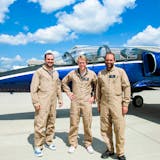With more smartphones equipped with macro lenses, you no longer need to haul around a big camera to capture decent views of delicate snowflakes.
Look for where they tumble down across cold windshields, or catch one on a dark-colored glove or mitten and snap a photo before it melts. A pocket magnifying lens works, too, for a quick look.
Snowflakes begin as water vapor in clouds at about 10,000 feet or higher in the atmosphere. Low temperatures transform these vapor particles into ice crystals, with humidity and wind also influencing how they form until they’re heavy enough to tumble down to Earth. It’s a journey that can take hours, according to Kenneth Libbrecht, a North Dakota native and California Institute of Technology physics professor who’s a longtime snowflake expert.
Libbrecht’s series of Minnesota-published books featuring photography of snowflakes spark appreciation and fascination for ice crystals’ multifaceted shapes, textures and details.
Stellar dendrites, the six-armed hexagonal shapes that inspire intricate paper snowflakes in elementary classrooms and ornaments on Christmas trees, typically form when there is some humidity and temperatures hover in the 10s and 20s.
Other temperatures create simpler snowflake forms, such as tiny needles or capped columns. A microscope will show even these simple shapes also have a six-sided design, which comes from the way water molecules bond and stack as an ice crystal forms.
The largest snowflakes Libbrecht captured were fernlike stellar dendrites, six-armed crystals up to 5 millimeters wide and full of intricate branches. They’re also superstars when it comes to reflecting sunlight, moonlight and streetlight for sparkly effects straight out of a Hallmark movie.
You can learn more about the science of snowflakes and how to identify a variety of prisms, plates, columns, dendrites, 12-branched-stars, and other forms at snowcrystals.com.


